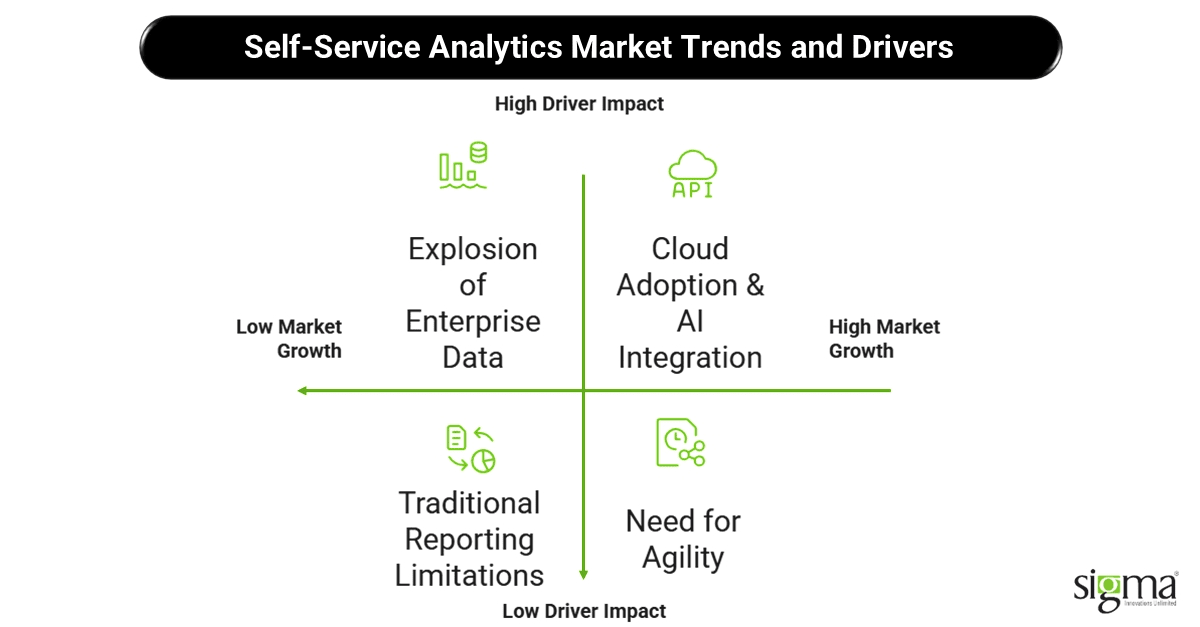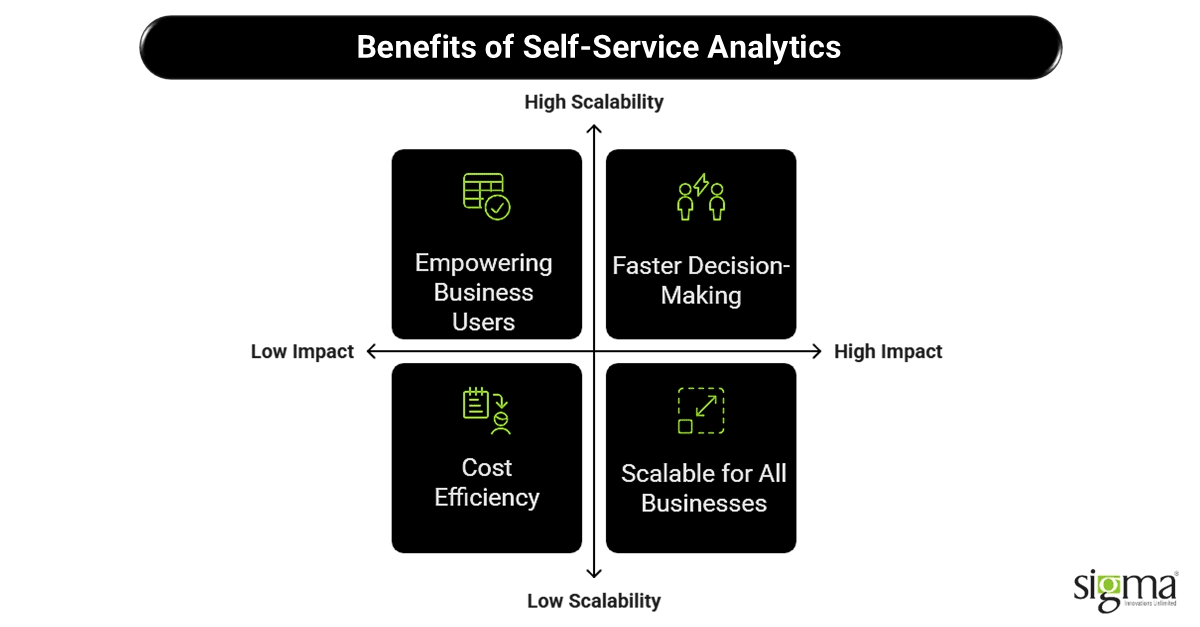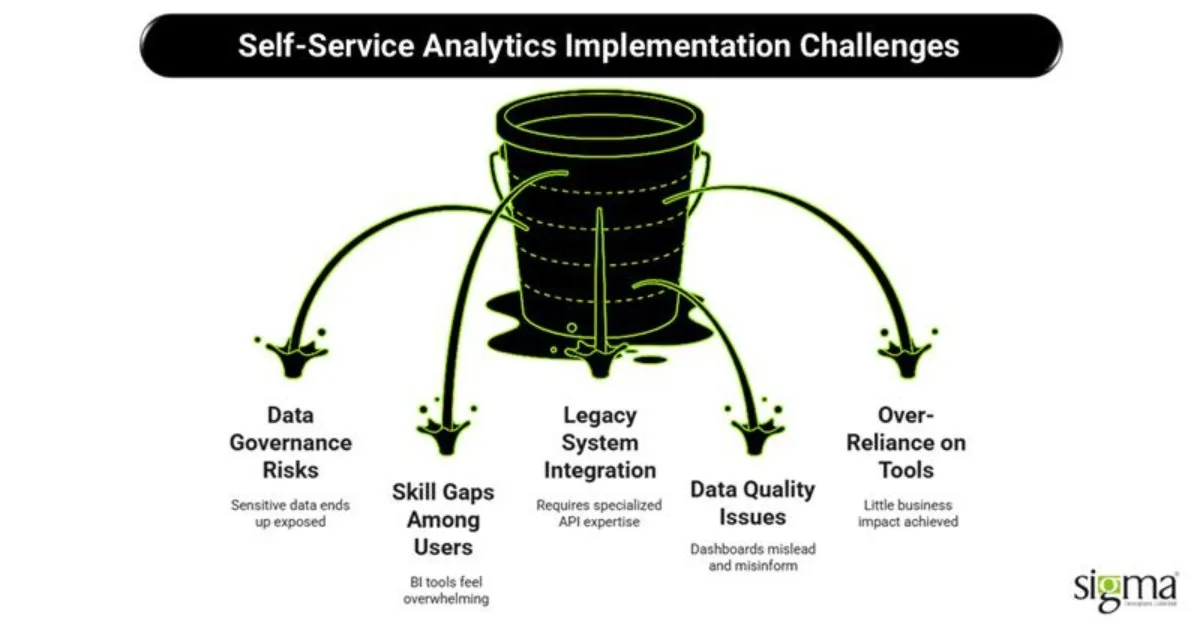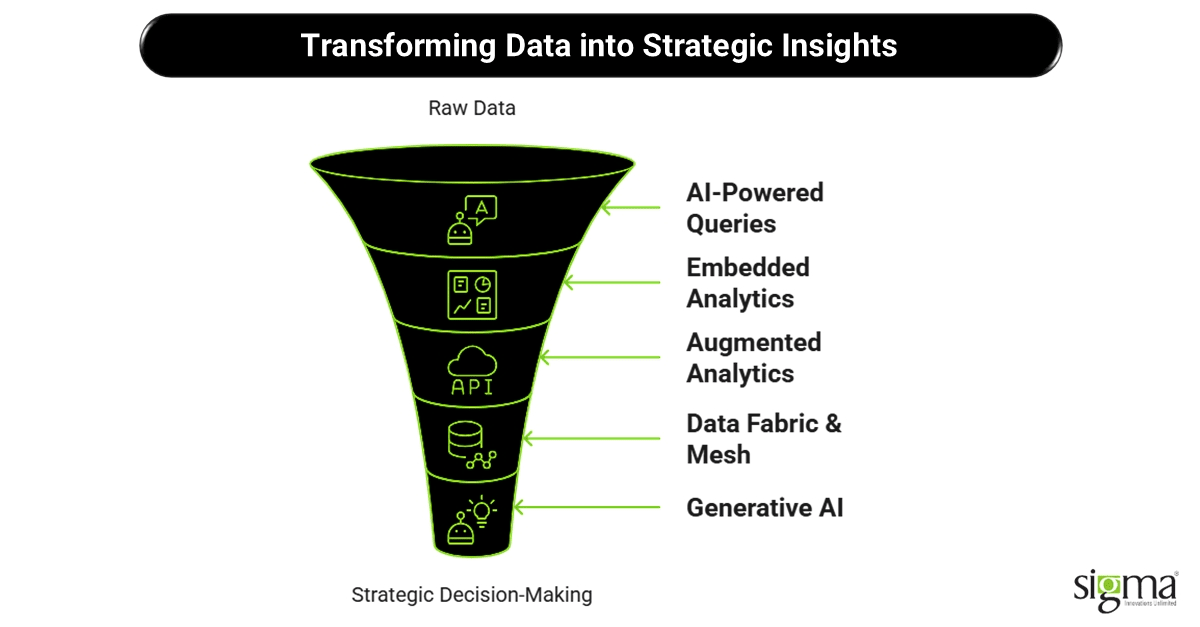Emerging trend of self-service analytics and the best tools available to you

Not too long ago, if a business team wanted a report or dashboard, they had to wait on IT or a data analyst to build it. That often meant delays, back-and-forth emails, and missed opportunities. Enter self-service analytics—a fast-rising trend that puts data directly into the hands of business users. Instead of depending on specialized teams for every question, employees can now explore data, build dashboards, and track KPIs on their own using self-service analytics tools.
This shift represents a major change in the world of analytics. We’re moving away from an era of centralized, IT-driven reporting and toward one where decision-makers across departments have real-time data access for business teams. Think of it as going from waiting in a long line at a cafeteria to having your own mini kitchen—you get the insights you need, when you need them.
So why is this happening now? Businesses today operate in a world that’s faster, more digital, and more competitive than ever. Whether it’s tracking supply chain performance, monitoring fintech dashboards, or analyzing customer behavior, companies need business intelligence solutions that give them speed, flexibility, and accuracy.
In this blog, we’ll explore the emerging trend of self-service analytics—covering the latest market shifts, benefits, challenges, and top tools. We’ll also share how Sigma Infosolutions’ BI & Analytics Development Services empower organizations to embrace this change with confidence.
The Rise of Self-Service Analytics: Market Trends & Drivers
The demand for faster, smarter, and more accessible insights has made self-service analytics one of the hottest trends in the BI space. The business intelligence market is on a rapid growth trajectory. Presently valued at $31.98 billion, it’s poised to reach $63.20 billion by 2032, with an impressive 8.9% CAGR. What’s fueling this growth? The shift toward self-service BI tools, which now account for nearly 60% of new BI deployments worldwide.

Key Drivers Behind the Shift
- Explosion of Enterprise Data – Businesses are generating unprecedented amounts of data from transactions, customer interactions, IoT devices, and digital channels. Traditional reporting can’t keep up.
- Cloud Adoption & AI Integration – Cloud platforms and embedded AI have lowered the barriers to analytics, making user-friendly analytics tools scalable and affordable.
- Need for Agility – To pivot strategies and seize new opportunities, business teams in today’s fast-changing markets need instant access to real-time data.
Industry Perspectives
- eCommerce companies are adopting real-time inventory analytics dashboards to optimize stock levels.
- Fintechs rely on self-service KPIs for fintech dashboards to track fraud detection, loan performance, and customer behavior.
- Healthcare is using data democratization platforms to improve patient outcomes and streamline operations.
- Retail is driving growth through customer-centric insights, while manufacturing uses logistics and supply chain BI to predict disruptions and reduce downtime.
Looking Ahead: The Next 3–5 Years
The future of business intelligence solutions will be defined by deeper AI-driven automation, voice-based queries, and predictive insights becoming mainstream. Expect user adoption of BI tools to grow even faster as employees gain more confidence in navigating data. The line between “data experts” and “business users” will continue to blur, making self-service analytics not just a trend but the default way organizations consume insights.
For businesses, this means the opportunity is clear: embrace BI and analytics services now, or risk being left behind in a world where speed and data-driven agility define winners and losers.
Also Read: Embedded Business Intelligence Solutions That Power Data-Driven Products
Why Businesses are Embracing Self-Service Analytics
Waiting days—or even hours—for a report from IT can feel like an eternity in our digital-first world. That’s why so many companies are turning to self-service analytics. These tools and platforms allow business users to cut through the bottlenecks and make faster, data-backed decisions.

Faster Decision-Making
The biggest driver is speed. When teams don’t have to rely on IT for every dashboard or KPI, they can respond in real time. Marketing teams can track campaign performance instantly, sales teams can monitor pipeline health, and operations can adjust processes on the fly. This level of agility simply isn’t possible with old-school, centralized reporting.
Empowering Business Users
Another reason for the shift is empowerment. With self-service analytics tools, employees across functions can directly explore data and answer their own questions. Instead of waiting for technical support, they can slice and dice data themselves—building confidence and boosting adoption of BI.
Cost Efficiency
There’s also a financial upside. By reducing dependency on external reporting teams, companies lower costs and see a faster ROI. Simply put, less manpower spent on manual reporting means more resources for strategy and innovation.
Scalable for All Businesses
Whether you’re a startup running lean or a global enterprise with complex operations, business intelligence solutions scale to fit. Self-service platforms can grow with the business, supporting new data sources, teams, and use cases without major disruptions.
Role of BI & Analytics Services
While the tools are powerful, they don’t run themselves. That’s where BI & analytics development services come in. Expert service providers like Sigma Infosolutions help organizations integrate self-service platforms into existing ecosystems, customize dashboards for unique needs, and ensure proper governance for security and compliance. With the right business intelligence and data analytics services, companies don’t just deploy tools—they unlock their full potential.
Challenges in Implementing Self-Service Analytics
While the promise of self-service analytics is exciting, the reality of implementing it comes with its share of roadblocks. For many organizations, rushing into adoption without addressing these hurdles can create more problems than solutions.

- Data Governance & Security Risks: When multiple business users access data directly, questions around governance and security naturally arise. Without proper controls, sensitive information may end up in the wrong hands—or worse, lead to compliance violations. Business intelligence and data analytics services must be implemented with role-based access and clear governance policies to avoid these risks.
- Skill Gaps Among Business Users: Not every employee is a data wizard. Sales, marketing, and operations professionals may be experts in their domain, but using BI tools effectively can still feel overwhelming. This often results in low adoption rates and underutilized tools. Organizations need training programs and user-friendly solutions that bridge these gaps.
- Integration with Legacy Systems: Most businesses aren’t starting from scratch—they have CRMs, ERPs, or custom legacy platforms already in place. Integrating modern self-service analytics tools with these systems can be complex, requiring specialized expertise in APIs, data pipelines, and cloud migration.
- Data Quality Issues: The old saying “garbage in, garbage out” applies perfectly here. If the underlying data is inaccurate, incomplete, or siloed, the dashboards will mislead more than they inform. Ensuring clean, unified, and reliable data is critical for trust in insights.
- Over-Reliance on Tools Without Strategy: Finally, tools alone can’t solve business problems. Many companies make the mistake of deploying business intelligence solutions without a clear analytics strategy in place. The result? Fancy dashboards with little business impact.
Sigma Infosolutions as a Strategic Partner
This is where Sigma Infosolutions makes a difference. Our BI & analytics development services don’t just plug in tools—we help companies design a solid strategy, ensure seamless integration, and implement governance frameworks. From improving data quality to customizing dashboards, we ensure your BI and analytics services deliver real, measurable business outcomes. With us, businesses can avoid common pitfalls and turn self-service analytics into a true competitive advantage.
The Role of BI & Analytics Services in Driving Self-Service Success
Buying the latest self-service analytics tools is a good start—but it’s far from enough. Many companies quickly discover that simply adding a new dashboarding platform doesn’t guarantee better decision-making. Without the right strategy, integration, and support, even the most powerful tools can become underutilized or misaligned with business goals. That’s where BI and analytics services come in.
Beyond the Tool: The Power of Services
- End-to-End Implementation: From integrating new platforms with CRMs, ERPs, and legacy systems to customizing dashboards for specific departments, business intelligence and data analytics services ensure smooth deployment. Instead of one-size-fits-all, businesses get solutions tailored to their processes and goals.
- Data Strategy & Governance: Self-service without governance can turn into chaos. Service providers establish robust data strategies, role-based access controls, and governance frameworks to maintain compliance and security while still empowering business users.
- Advanced Analytics Capabilities: Basic dashboards answer the “what happened” questions. With the help of BI & analytics development services, companies can take it further—leveraging AI and machine learning to predict future outcomes, detect anomalies, and unlock hidden opportunities.
- User Training & Adoption: Even the most intuitive self-service BI tools can fail if users don’t feel comfortable using them. Ongoing training and change management are key to building confidence and ensuring widespread adoption across teams.
At Sigma Infosolutions, we help businesses bridge the gap between technology and impact. Our business intelligence solutions are designed not just for implementation, but for outcomes—faster decisions, stronger strategies, and real competitive advantage. By combining bi and analytics services with domain expertise across industries like eCommerce, fintech, healthcare, and retail, we ensure companies don’t just adopt tools—they master them.
With the right partner, self-service analytics transforms from a shiny dashboard into a driver of measurable growth. Sigma Infosolutions makes sure that transformation sticks.
Best Self-Service Analytics Tools in 2025
With so many self-service analytics tools on the market, choosing the right one can feel like picking the perfect car—you need something that’s not just shiny, but reliable, efficient, and built for your specific road ahead. To help cut through the noise, let’s look at the leading options based on ease of use, scalability, integration, AI features, and cost-effectiveness.
Power BI
A favorite among enterprises, Microsoft Power BI offers seamless integration with Office 365 and Azure. It’s scalable, affordable, and especially strong for organizations already invested in the Microsoft ecosystem.
Tableau
Known for its world-class data visualization, Tableau is ideal for enterprise use cases where complex datasets need to be presented in engaging, easy-to-understand formats. It also offers strong community support and advanced analytics extensions.
Qlik
Qlik’s associative data model lets users explore relationships across datasets without needing predefined queries. It’s particularly powerful for businesses that deal with complex, interconnected data.
Looker (Google Cloud)
Looker takes a modern BI approach with embedded analytics and strong integration within Google Cloud. It’s well-suited for organizations that want scalable, cloud-first business intelligence.
Domo
A cloud-native platform designed with collaboration in mind, Domo makes it easy for distributed teams to share dashboards and insights. It also offers mobile-friendly features for on-the-go executives.
Sisense
Sisense shines when it comes to embedding analytics into customer-facing apps or enterprise products. Companies looking to create real-time inventory analytics dashboards or integrated fintech portals often lean toward this option.
Next-Gen Tools (Tellius, ThoughtSpot, Luzmo)
The new wave of AI-powered tools is redefining how we interact with analytics. Platforms like ThoughtSpot and Tellius enable natural language queries (“show me sales trends for Q2”) while Luzmo focuses on interactive, customizable dashboards. These are strong contenders for businesses prioritizing AI-driven insights and user adoption.
Comparative Overview: Self-Service Analytics Tools in 2025
| Tool | Ease of Use | Scalability | AI Features | Best Fit Industries |
|---|---|---|---|---|
| Power BI | High | High | Moderate | Enterprises, Financial Services |
| Tableau | Medium | High | Moderate | Retail, Healthcare, Marketing |
| Qlik | Medium | High | Moderate | Manufacturing, Supply Chain |
| Looker | High | High | Strong | eCommerce, Cloud-Native Startups |
| Domo | High | Medium | Moderate | Remote Teams, Collaboration-Heavy Firms |
| Sisense | Medium | High | Strong | SaaS, Fintech, Embedded Analytics |
| ThoughtSpot / Tellius / Luzmo | High | High | Advanced (AI/ML, NLP) | Digital-First Enterprises, Data-Driven SMEs |
Also Read: The Ultimate AI Playbook for Grocery Retailers in 2025
Future of Self-Service Analytics: Emerging Innovations
The future of self-service analytics looks less like dashboards and more like conversations. Thanks to advances in AI, the way business users interact with data is undergoing a major transformation.

AI-Powered Query Generation
Natural language processing (NLP) is making analytics more human. Instead of writing complex queries, business users can now ask simple questions like, “What were my Q4 sales in the Northeast?” and instantly get a visual answer. This chat-based BI approach reduces the learning curve and accelerates user adoption of BI tools.
Embedded Analytics in Workflows
Analytics is moving closer to where work happens. Imagine a CRM, ERP, or eCommerce platform where insights are built directly into the interface. This trend of embedded analytics ensures teams make smarter decisions without leaving their day-to-day tools.
Augmented Analytics
Beyond descriptive dashboards, augmented analytics is rising—powered by AI and ML. These tools not only tell you what happened but also why it happened and what’s likely to happen next. The result is more predictive, prescriptive decision-making with minimal user input.
Data Fabric & Data Mesh Influence
As organizations adopt data fabric and data mesh architectures, self-service becomes easier. These modern frameworks break down silos, making clean, reliable data more accessible across the business.
Generative AI in Analytics
Perhaps the most exciting development is Generative AI. Imagine analytics tools that don’t just respond to queries but proactively surface insights, flag anomalies, and recommend next steps. This shift makes analytics not just self-service, but self-initiating—transforming how businesses operate.
The takeaway? The next three to five years will redefine business intelligence solutions as intuitive, AI-driven, and seamlessly woven into business workflows.
Strategic Takeaways for Businesses
At this point, one thing is clear—self-service analytics is no longer a “nice to have.” It’s becoming a core requirement for businesses that want to compete in fast-moving markets. Organizations that still rely solely on IT-driven reporting risk falling behind competitors who empower their teams with real-time insights.
But success doesn’t come from tools alone. Companies that thrive with business intelligence solutions share a few common practices:
- Governance – Clear rules on data security, compliance, and access.
- Smart Tool Selection – Choosing self-service analytics tools that fit their scale, industry, and ecosystem.
- User Training – Ensuring business users feel confident exploring data on their own.
- Expert BI Services – Leveraging specialized partners for integration, customization, and advanced analytics.
This is where Sigma Infosolutions makes a real difference. With our BI & analytics development services, we don’t just help you adopt dashboards—we help you build a future-ready analytics ecosystem. From strategy to implementation and ongoing optimization, our business intelligence and data analytics services ensure your teams not only use the tools, but actually turn insights into better business outcomes.
For decision-makers, the takeaway is simple: investing in the right mix of technology and expertise today creates a long-term advantage tomorrow. And with Sigma Infosolutions as your partner, you don’t just keep up with the trend—you stay ahead of it.
Ready to Unlock the Power of Self-Service Analytics?
The future belongs to businesses that treat data as a strategic asset. The question is—where does your organization stand today? Are your teams empowered with real-time insights, or are they still waiting on IT for every report?
At Sigma Infosolutions, we help companies assess their BI maturity and take the next step with confidence. From strategy assessments and tool implementation to migration and managed analytics services, our Business Intelligence Consulting Services are built to deliver measurable impact.
Don’t let data be a bottleneck—turn it into your competitive edge.
Explore how Sigma Infosolutions can help you transform data into a competitive advantage with self-service analytics.

